Light and Shadow of Reconstruction
Shortage of Food and Supplies
After the A-bombing, black markets were established in front of Hiroshima, Yokogawa and Koi Stations. Despite their exorbitant prices, these black markets were important for the survival of civilians who were suffering from a lack of food, which was rationed. Related to black markets was the appearance of transporters of goods, especially black-market rice, who were called "humpers." It was very likely that consumers who originally had traveled to the suburbs to buy goods, carrying a large bag on their shoulders, gradually took up a new "career" as humpers. Next to food, clothes and daily necessities were items that people lacked. While clothes from military stocks could be diverted for the daily use, daily necessities such as umbrellas, pots and pans, buckets, rubber boots and bicycle tires were very difficult to procure.
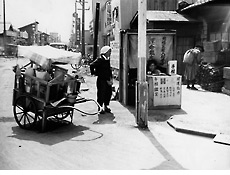 "Humper," fortuneteller, and flower vendor1949
|
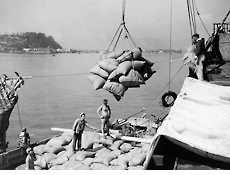 Unloading imported rice1950
|
|
 Repairmen1952
During, and for a while after the war, metalware including pots and pans were articles of value. Even if they had cracks and holes, it was thought more reasonable to fix, rather than replace them. Peddlers who also repaired items such as umbrellas and metal basins roamed around the city.
|
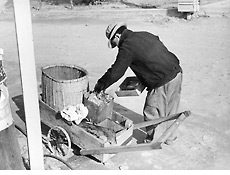 Collection of waste articles1953
A man collecting waste articles in the area around the east end of Aioi Bridge. Pulling a hand-made cart, he makes his rounds around the city to collect and sell metal products and crockery. In an age when people seeking work could not find any jobs, collecting waste articles was one of the readily available ways to earn cash income.
|
Housing Problems
Although an improvement in the availability of food and commodities began to appear from around 1949, the housing shortage was showing no sign of being alleviated. Hastily built public housing for A-bomb victims and people who had returned to Hiroshima after the war was not only insufficient, but the buildings were also aging rapidly. Some people were living in barracks made of scrap wood, and due to land readjustment, other people were forced to move out of the houses and stores they had constructed with difficulty.
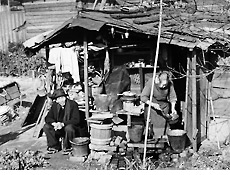 Elderly couple living in a shack1952
Even about 10 years after the A-bombing these people were still living in air-raid shelters made during the war. A sizeable number of people were living in shacks made of galvanized plates and scrap wood that had been left unburned.
|
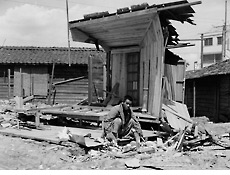 Demolishing a newly built house by himself1953
Some people were pressured to move out of their residences due to land readjustments despite all their efforts to build them. This man is demolishing his newly built house by himself.
|
|
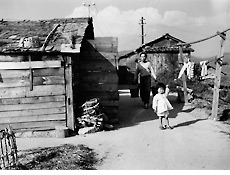 Decrepit shacks1953
Since the public houses and shacks on the former site of the Western Drill Ground in Moto-machi were hastily built, these buildings aged rapidly and were soon seen as a problem from the viewpoints of disaster prevention, crime prevention, and proper hygiene. However, residents of these buildings had nowhere else to go, so they had no choice but to continue living there.
|
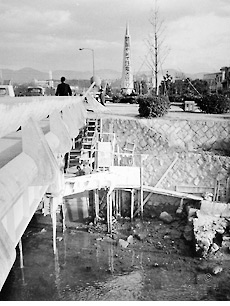 Living under a bridge1961
View looking east from the west end of Heiwa-ohashi Bridge, which was completed in 1952. An advertising pillar reading "Avoid honking your horn, pay attention and slow down" appears in the greenbelt along Peace Boulevard. Even after the number of automobiles increased to a degree that the noise became a problem, people continued living under the bridge in spaces created from erected scaffolding.
|
